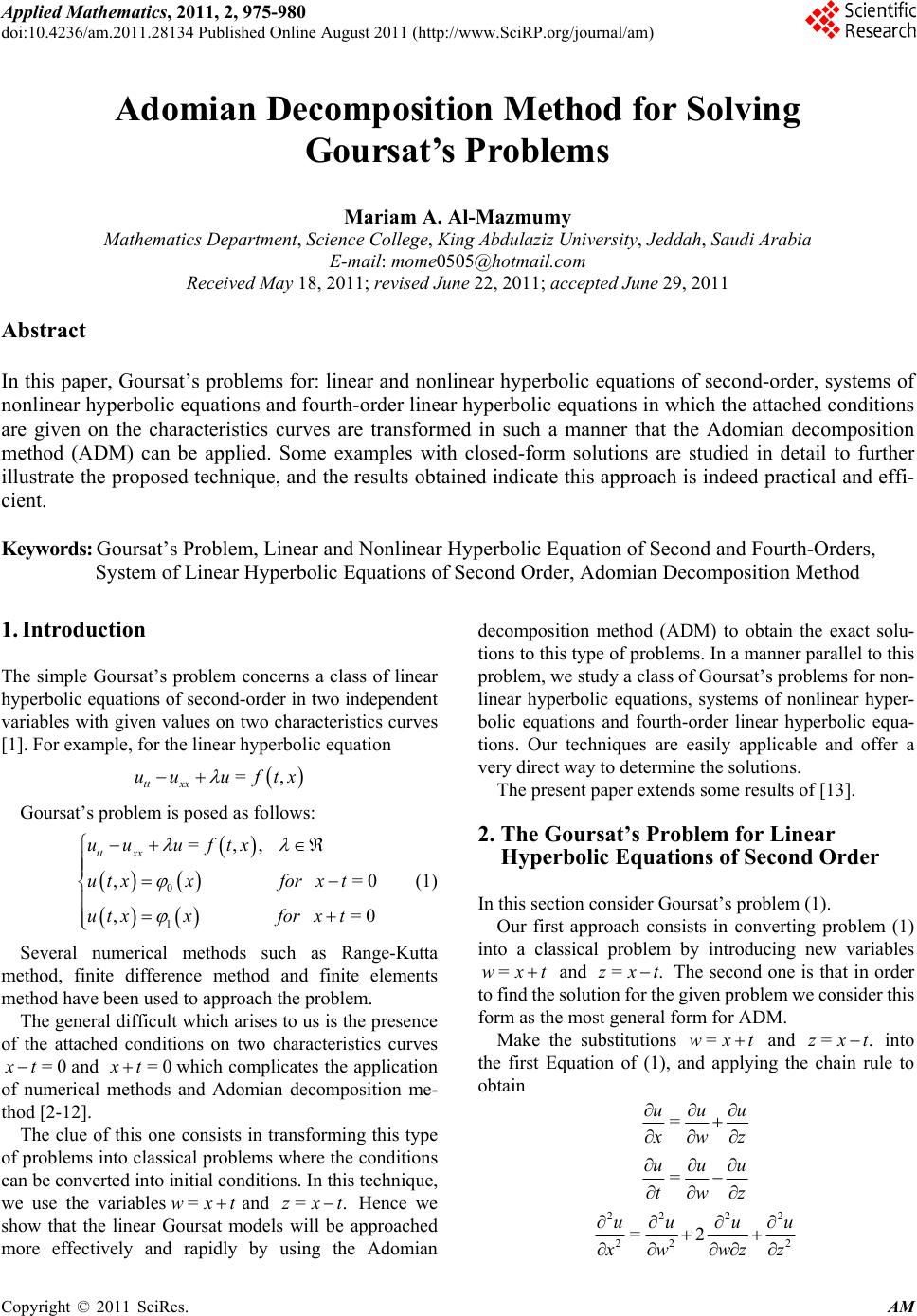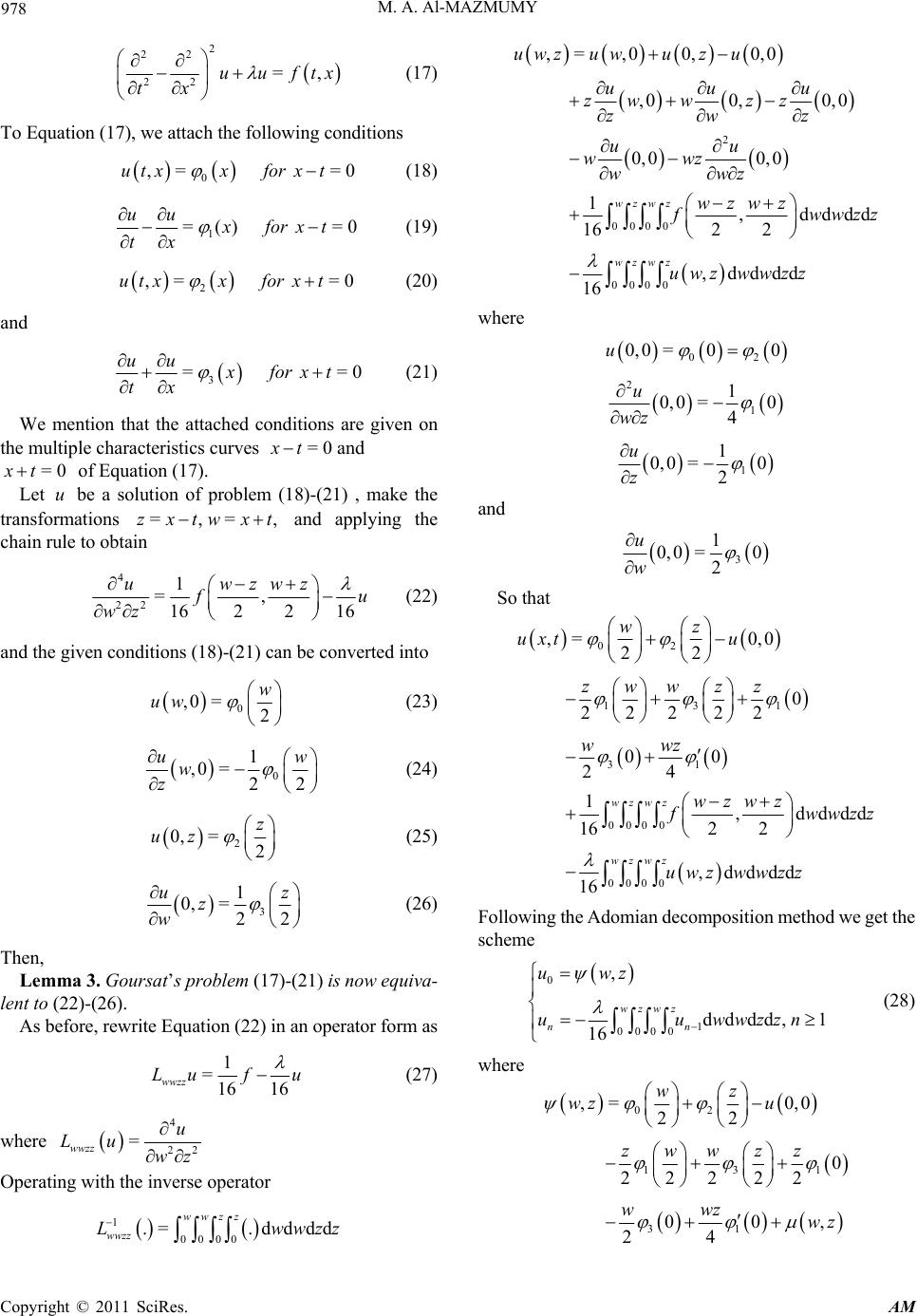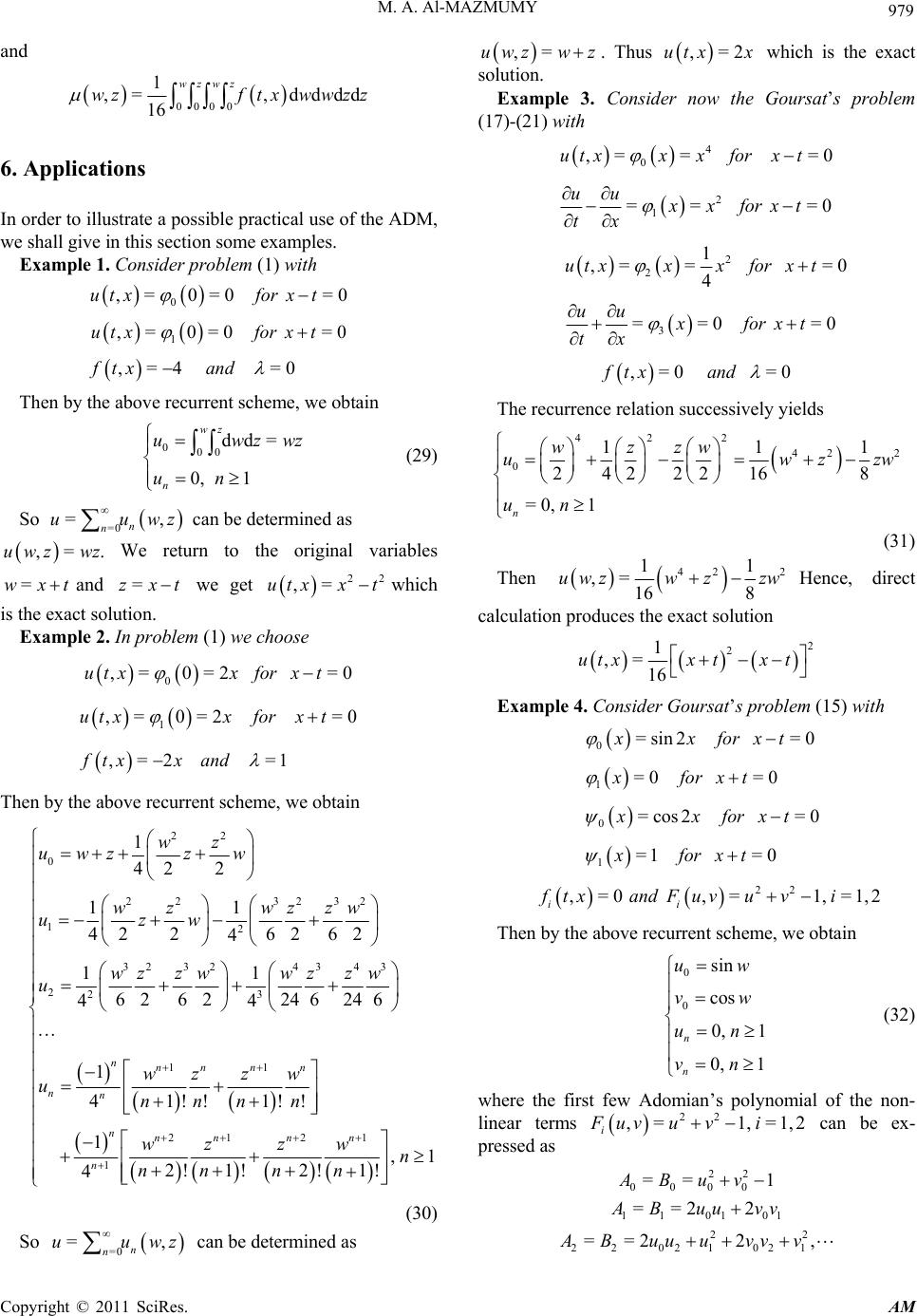 Applied Mathematics, 2011, 2, 975-980 doi:10.4236/am.2011.28134 Published Online August 2011 (http://www.SciRP.org/journal/am) Copyright © 2011 SciRes. AM Adomian Decomposition Method for Solving Goursat’s Problems Mariam A. Al-Mazmumy Mathematics Department, Science College, King Abdulaziz University, Jeddah, Saudi Arabia E-mail: mome0505@hotmail.com Received May 18, 201 1; revised June 22, 2011; accepted June 29, 2011 Abstract In this paper, Goursat’s problems for: linear and nonlinear hyperbolic equations of second-order, systems of nonlinear hyperbolic equations and fourth-order linear hyperbolic equations in which the attached conditions are given on the characteristics curves are transformed in such a manner that the Adomian decomposition method (ADM) can be applied. Some examples with closed-form solutions are studied in detail to further illustrate the proposed technique, and the results obtained indicate this approach is indeed practical and effi- cient. Keywords: Goursat’s Problem, Linear and Nonlinear Hyperbolic Equation of Second and Fourth-Orders, System of Linear Hyperbolic Equations of Second Order, Adomian Decomposition Method 1. Introduction The simple Goursat’s problem concerns a class of linear hyperbolic equations of second-order in two independent variables with given values on two characteristics curves [1]. For example, for the linear hyperbolic equation =, tt xx uu uftx Goursat’s problem is posed as follows: 0 1 =,, ,= , tt xx uu uftx utxxfor xt utxxfor xt 0 =0 . (1) Several numerical methods such as Range-Kutta method, finite difference method and finite elements method have been used to approach the problem. The general difficult which arises to us is the p resence of the attached conditions on two characteristics curves and which complicates the application of numerical methods and Adomian decomposition me- thod [2-12]. =0xt=0xt The clue of this one consists in transforming this type of problems into classical problems where the conditions can be converted into initial conditions. In this tech n ique, we use the variablesand Hence we show that the linear Goursat models will be approached more effectively and rapidly by using the Adomian decomposition method (ADM) to obtain the exact solu- tions to this type of prob lems. In a manner parallel to this problem, we study a class of Goursat’s problems for non- linear hyperbolic equations, systems of nonlinear hyper- bolic equations and fourth-order linear hyperbolic equa- tions. Our techniques are easily applicable and offer a very direct way to determine the solution s. =wxt=zxt The present pa per extends som e result s of [ 13] . 2. The Goursat’s Problem for Linear Hyperbolic Equations of Second Order In this section consider Goursat’s prob lem (1). Our first approach consists in converting problem (1) into a classical problem by introducing new variables =wxt and =zxt. The second one is that in order to find the solution for the given problem we consider this form as the most general form for ADM. Make the substitutions and =wxt=zxt. into the first Equation of (1), and applying the chain rule to obtain = uuu wz = uuu twz 22 22 22 =2 uu u wz 2 u wz  976 M. A. Al-MAZMUMY 22 22 22 =2 uu u wz tw z 2 u Then the first Equation of (1) becomes 2 4= , 22 uwzwz fu wz (2) Also the given conditions of (1) can be converted into 0 ,0 =2 w uw (3) 1 0, =2 z uz (4) Then, Lemma 1. Goursat’s problem (1) is equivalent to (2)-(4). Now we shall use the Adomian’s decomposition method [2-12] for solving (2)- (4 ). Consider Equation (2) in an operator form as 1 =44 wz Luf u (5) where 2 = wz u Lu wz Operating with the inverse operator we have 1 00 (.) =(.)dd, wz wz L wz 01 00 00 ,= 0,0 22 1,d 422 ,dd 4 wz wz wz uwz u wzwz d wz uwz wz (6) where . 01 0,0 =00u Following the Adomian decomposition method the unknown solution is assumed to be given by a series u of the form where the com- =0 ,= , n n uwzu wz ponents are going to be determined recurrently. , n uwz Thus, we get the schem e 00 1 00 1 00 =0 22 1,d 422 =dd,1 4 wz wz nn wz uu wzwz ,0 d wz uuwzn (7) Now, by summing the first 1n terms of =0 ,= , n n uwzu wz we obtain the approxi- nth mation to the solution as =0 =, n ni i Sun 0 i (8) or 0=1 =n n i Su u (9) By substitution of the recursive scheme (7) into this sum, we conclude that the ADM for Goursat’s problem (1) can be converted to an equivalent problem, which we state as follows Theorem 1. The ADM for Goursat’s problem (1) is equivalent to the following problem: Find the sequence Sn such that and satisfies 01 = nn Suu u 00 1 00 01 00 0,0 22 1,d 422 =dd, 4 wz wz nn wz uu wzwz d 1 wz Su Swzn (10) Also, the result concerning the convergence analysis of the ADM for problem (1) can be stated as follows Theorem 2. Let be a sequence defined by (10). If n S 0<u and there exist a constant 0<1, such that 1n u n u then is convergent. n S Proof. We have 112 21 = nmnn n nnm m SSSSS SSSS for then ,nm 1121 ... nmnnn nm m SSSSS SSS Thus 11 00 nn m nm SS uuu 0 Therefore 11 0 1 mnm nm SS u As =0 i i is a geometric series with the common ratio , 0<1. By induction we see that 1 0 1 m nm SS u and 0, nm SS as thus converges for ,m n S 0<1 so we have convergence in norm. Copyright © 2011 SciRes. AM  M. A. Al-MAZMUMY 977 0 3. The Goursat’s Problem for Nonlinear Hyperbolic Equations of the Second Order The same procedure can be adopted to resolve the following nonlinear hyperbolic equation of the second order 0 1 =, ,= =0 ,= tt xx uu uftxFu utxxforx t utxxfor xt (11) where the nonlinear term is represented by u. As before, we have Lemma 2. The nonlinear Goursat’s problem (11) is equivalent to 2 0 1 4, 22 ,0 2 0, 2 uwzwz uFu wz w uw z uz (12) Substituting the decomposition =0 ,= , n n uwzu wz into (12) and define u by 01 =0 = n n ,,, n uAu uuwhere then are the Ado- mian polynomials [2, 3], which depend only on the components . Thus we get the recursive scheme 01 ,,, n uu u 00 1 11 00 00 0,0 22 1 dddd, 1 44 wz wz nn n wz uu uuwzAwzn (13) As before, we conclude that the ADM for Goursat’s problem (11) can be converted to an equivalent problem. Theorem 3. The ADM for Goursat’s problem (11) is equivalent to the following problem: Find the sequence n such that and satisfies S u 01 = nn Suu 00 1 00 01 00 0,0 22 1,dd 422 dd,1 4 wz wz nn wz uu wzwz wz SuFS wzn (14) 4. The Goursat’s Problem for System of Nonlinear Hyperbolic Equations of the Second Order We shall extend this method to the following system of nonlinear hyperbolic equations of the second order 11 22 0 1 0 1 ,, ,, ,= ,= ,= ,= =0 tt xx tt xx uu Fuv ftx vv Fuv ftx utxxforxt utxxforx t vtxxfor xt vtxxforx t 0 0 0 (15) where the nonlinear terms are represented by ,, i uv . =1,2 i By the same way as given in the nonlinear hyperbolic Equation (11), the scheme for system (15) can be expressed as 00 1 1 00 00 1 2 00 1 00 1 00 0,0 22 1(,)dd 422 0,0 22 1(,)dd 422 1 =dd,1 4 1 =dd,1 4 wz wz wz nn wz nn wz uu wzwz wz wz vv wzwz wz uAwzn vBwzn (16) where 1010 =0 ,= ,,,;,,, nn n1n uvA u uu v vv 20101 =0 ,= ,,,;,,, nnn n and uvBu uu v vv n and and n B are the Adomian polynomials [2,3]. 5. The Goursat’s Problem for Linear Hyperbolic Equation of Fourth Order In a manner parallel to the previous section, we study a linear hyperbolic equation of fourth-order with multiple characteristics curves. The Goursat’s problem for this equation is formulated as follows: Copyright © 2011 SciRes. AM  978 M. A. Al-MAZMUMY 2 22 22 =,uuftx tx (17) To Equation (17), we attach the following conditions 0 ,= =0utxxforxt (18) 1 =() =0 uu xforxt tx (19) 2 ,= =0utxxforx t (20) and 3 == uu xforxt tx 0 , (21) We mention that the attached conditions are given on the multiple characteristics curves and of Equation (17). =0xt =0xt Let be a solution of problem (18)-(21) , make the transformations and applying the chain rule to obtain u=,=zxtwxt 4 22 1 =, 162 216 uwzwz f wz u (22) and the given conditions (18)-(21) can be converted into 0 ,0 =2 w uw (23) 0 1 ,0 =22 u w z w (24) 2 0, =2 z uz (25) 3 1 0,= 22 u z w z (26) Then, Lemma 3. Goursat’s problem (17)-(21) is now equiva- lent to (22)-(2 6 ). As before, re w rite Eq uation ( 22) i n a n o pe ra tor f orm as 1 =16 16 wwzz Luf u (27) where 4 22 = wwzz u Lu wz Operating with the inverse operator 1 0000 .= .dddd wwzz wwzz Lw 2 0000 0000 ,= ,00,0,0 ,0 0,0,0 0,0 0,0 1,ddd 162 2 ,dddd 16 wzwz wzw z uwzuwuz u uuu zw wzz zwz uu wwz wwz wzwz d wwzz uwz wwzz where 02 0,0 =00u 2 1 1 0,0 =0 4 u wz 1 1 0,0 =0 2 u z and 3 1 0,0 =0 2 u w So that 02 131 31 0000 0000 ,= 0,0 22 0 22222 00 24 1,ddd 162 2 , dddd 16 wzw z wzwz wz uxt u zwwzz wwz wzwz d wwzz uwz wwzz Following the Adomian decom position method we get the scheme 0 1 0000 , dddd, 1 16 wzwz nn uwz uu wwzzn (28) where 02 13 31 ,= 0,0 22 0 22222 00 24 wz wz u zwwzz wwzwz 1 , wzz Copyright © 2011 SciRes. AM  M. A. Al-MAZMUMY 979 and 0000 1 ,= ,dddd 16 wzwz wzftxwwzz 6. Applications In order to illustrate a possible practical use of the ADM, we shall give in this section some examples. Example 1. Consider pro blem (1) with 0 ,= 0=0=0utxforx t 1 ,= 0=0=0utxforx t ,=4 =0ftxand Then by the above recurrent scheme, we obtain 000 dd= 0, 1 wz n uwz un wz ,z 2 (29) So can be determined as We return to the original variables and we get which is the exact solution. =0 = n n uuw ,=.z wz t=zxt uw =wx 2 ,=utxx t Example 2. In problem (1) we choose 0 ,= 0=2=0utxxforxt 1 ,= 0=2=0utxxforx t ,=2 =1ftxx and Then by the above recurrent scheme, we obtain 22 0 22 3232 12 323 24343 223 11 212 1 1 1 42 2 11 42262 62 4 11 6262246246 44 1 1! !1!! 4 1 2! 1!2! 4 nnnn n nn nnnn n n wz uwzzw wz wzzw uzw wz zwwz zw u wz zw unnnn wz zw nn nn ,1 1! n (30) So can be determined as =0 = n n uuw ,=uwzw z . Thus ,=2utxx which is the exact solution. Example 3. Consider now the Goursat’s problem (17)-(21) with 4 0 ,= ==0utxxxforx t 2 1 == = uu xxforxt tx 0 2 21 ,= ==0 4 utxxxfor xt 3 ==0 = uu xforxt tx 0 ,=0 =0ft xand The recurrence relation successively yields 42 242 011 2422216 8 =0,1 n wzzw uw un 2 1 zzw (31) Then 42 11 ,= 16 8 uwzw zzw 2 Hence, direct calculation produces the exact solution 2 2 1 ,= 16 utxx txt Example 4. C onsider Gours at’s pr oblem (15) with 0=sin2 =0xxforxt 1=0 =0xforxt 0=cos2 =0xxforxt 1=1 =0xforxt 22 ,=0,= 1,=1,2 ii ftxandFuvu vi Then by the above recurrent scheme, we obtain 0 0 sin cos 0, 1 0, 1 n n uw vw un vn (32) where the first few Adomian’s polynomial of the non- linear terms 22 ,= 1,=1, i Fuvu vi 2 1 1 can be ex- pressed as 22 0000 ==ABuv 1101 0 ==2 2 Buuv 22 0210 ==2 2uuu vv v 2 22 1 ,AB v ,z Copyright © 2011 SciRes. AM  M. A. Al-MAZMUMY Copyright © 2011 SciRes. AM 980 z ,z t t 7. References Thus and can be =0 =, n n uuw =0 = n n vvw determined as and So that and . ,=sinuwzw sinx t ,=cosvwz w ,=cosx t ,=utx vtx [1] E. Goursat, “A Course in Mathematical Analysis, Vol. 3: Variation of Solutions and Partial Differential Equations of the Second Order and Integral Equations and Calculus of Variations,” Gauthier-Villars, Paris, 1923. Example 5. Finally, consider Goursat’s problem (17)- (21) with [2] G. Adomian, “Nonlinear Stochastic Operator Equations,” Academic Press, Orlando, 1986. 2 0=e 1=0 x xforx [3] G. Adomian, “Solving Frontier Problems of Physics: The Decomposition Method,” Kluwer Academic Publishers, Boston, 1994. 1=2 =0xforxt 2 2=1 e=0 x xforx [4] G. Adomian and R. Rach, “Transformation of Series,” Applied Mathematics Letters, Vol. 4, No. 4, 1991, pp. 69- 71. doi:10.1016/0893-9659(91)90058-4 3=2 =0xforxt [5] G. Adomian, R. Rach and R. E. Meyers, “A Modified Decomposition,” Computers & Mathematics with Appli- cations, Vol. 23, No. 1, January 1992, pp. 17-23. doi:10.1016/0898-1221(92)90076-T ,=e e=1 xt xt ftx and Then by the above recurrent scheme, we obtain 22 011 22 111 44 33 2 44 233 2 66 55 3 22 11 1 1 ee , 16 22 1 16 22 1() 12 12 16 1() 12 12 16 1() 360 360 16 12 =2! 2! 16 12 16 wz nnn nn n n n zw uw zw uwz zw wz zw uwz zw wz zw uw nn n z z 22 21 22 21 22! ,1 22! n n n n zw n wzn n [6] G. Adomian and R. Rach, “Inhomogeneous Nonlinear Partial Differential Equations with Variable Coeffi- cients,” Applied Mathematics Letters, Vol. 5, No. 2, March 1992, pp. 11-12. doi:10.1016/0893-9659(92)90101-E [7] G. Adomian and R. Rach, “Nonlinear Transformation of Series Part II,” Computers & Mathematics with Applica- tions, Vol. 23, No. 10, May 1992, pp. 79-83. doi:10.1016/0898-1221(92)90058-P [8] G. Adomian and R. Rach, “Modified Decomposition Solution of Nonlinear Partial Differential Equations,” Applied Mathematics Letters, Vol. 5, No. 6, November 1992, pp. 29-30. doi:10.1016/0893-9659(92)90008-W [9] G. Adomian and R. Rach, “Solution of Nonlinear Partial Differential Equations in One, Two, Three, and four Di- mensions,” World Scientific Series in Applicable Analysis, Vol. 2, 1993, pp. 1-13. [10] G. Adomian and R. Rach, “Modified Decomposition Solution of Linear and Nonlinear Boundary-Value Prob- lems,” Nonlinear Analysis, Vol. 23, No. 5, September 1994, pp. 615-619. doi:10.1016/0362-546X(94)90240-2 [11] G. Adomian and R. Rach, “Analytic Solution of Nonlin- ear Boundary-Value Problems in Several Dimensions by Decomposition,” Journal of Mathematical Analysis and Applications, Vol. 174, No. 1, 15 March 1993, pp. 118- 137. doi:10.1006/jmaa.1993.1105 [12] G. Adomian and R. Rach, “A New Algorithm for Match- ing Boundary Conditions in Decomposition Solutions,” Applied Mathematics and Computation, Vol. 58, No. 1, September 1993, pp. 61-68. doi:10.1016/0096-3003(93)90012-4 where =0 =e ! k n w nk w wk [13] A. Wazwaz, “The Decomposition Method for Approxi- mate Solution of the Goursat Problem,” Applied Mathe- matics and Computation, Vol. 69, No. 2-3, May 1995, pp. 299-311. doi:10.1016/0096-3003(94)00137-S So can be determined as =0 = n n uuw ,z ,=e e w uwz z Thus ,=e e tx x t ut which is the exact solution to this problem.
|